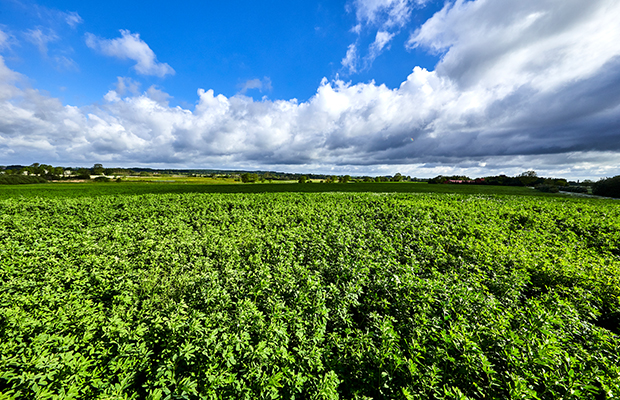|
Did you know: homegrown protein can have a positive impact on feed cost?
Denmark
September 14, 2020
Decreasing bought-in protein with a correspondingly increased amount of homegrown protein will help you to become more self-sufficient and reduce the reliance on and cost of bought-in protein.

The case for homegrown protein
Homegrown protein will offer you an important economic benefit and is a green solution:
- Self-sufficiency at farm level with less dependency on fluctuating world market prices for concentrates
- Positive environmental and climatic impact with carbon sequestration, improved soil structure, nitrogen fixation and biodiversity
The main tools to improve protein independence
When you want to increase the ratio of homegrown protein to be more self-sufficient there are things to be considered:
- Forages species and mixture composition
The first consideration is the choice of species. In grassland the share of e.g. alfalfa and clover can be increased to improve the protein content
- Grassland management
Cutting or grazing at the optimal stages of plant development is essential for maximizing outcome of energy and protein.
- Improving the protein and energy contribution of grasses
Grasses with increased fiber digestibility, lead to an increased amount of energy per kg dry matter. A higher intake results in higher animal output and better earnings; we call it DLF Fiber Energy.
Are clover-grass and alfalfa sustainable solutions?
Yes, legumes in your sward will for two reasons be an on-farm sustainable solution:
- Legumes are providing locally grown protein, limiting the import of protein and emissions from transport of overseas substitutes
- Legumes fixate nitrogen from the air, reducing the need for fertilising the soil. That has a positive climatic impact since production of nitrogen fertiliser is highly energy consuming.
With legumes you also gain better soil structure and create better diversity in your field. Read more about the benefits of clover in legumes in sustainable farming here.
More news from: DLF A/S
Website: http://www.dlf.com/ Published: September 14, 2020 |
|
The news item on this page is copyright by the organization where it originated
Fair use notice |